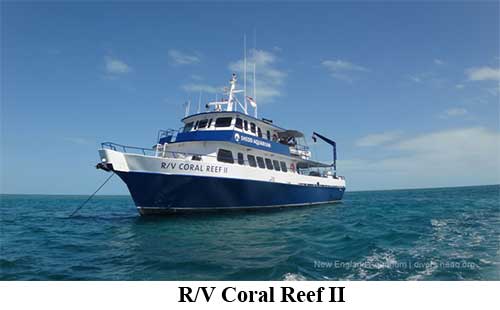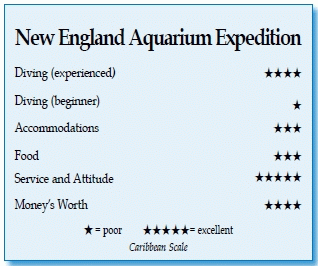R/V Coral Reef II, BahamasContents of this Issue: Cane Bay Dive Shop, St. Croix, U.S. Virgin Islands Experienced Divers Arenít Excited by Artificial Reefs Maldives, Hawaii, Indonesia . . . How Long Will Your Dive Computer Last? Warranties: What to Look at, What to Ask Travel Tips for Long-Haul Flights Good News about Lionfish Culling in the Caribbean The Fight to Stop Seahorse Photography Why Divers Should Be Excited about The Wave Editorial Office: Ben Davison Publisher and Editor Undercurrent 3020 Bridgeway, Suite 102 Sausalito, CA 94965 on the hunt for 1, 337 fish to stock the New England Aquarium from the November, 2013 issue of Undercurrent
Dear Diver: The New England Aquarium, on Boston's Central Wharf, needed a lot of fish. It was enlarging its Giant Ocean Tank, and to capture the fish needed, it had organized three one-week collecting expeditions to the Bahamas. Last year, I only made the waiting list, but this year, I had my choice and selected the third and last expedition, which sailed out of Miami in mid-March. All the Aquarium's expeditions (and those of many other aquariums and researchers) use the R/V Coral Reef II, an 80-foot, custom-built research and collection ship designed and owned by Chicago's Shedd Aquarium. While the living facilities -- a single lounge area -- were simple but adequate, I knew I was on an expedition when I shared a bathroom with three other cabins (each one had two bunks, a washbasin and closet). I was the first guest to board the ship at the Jones Boatyard, along the Miami River, on Saturday afternoon. The rest of the guests drifted in later. After an introduction and dinner, I climbed into my bunk. It would be a pre-dawn departure, under several raised drawbridges and past cargo terminals with their huge cranes. Once out of the river, it was a calm (unusually so, some said) five-hour crossing to Bimini in the Bahamas. At Bimini, a fisherman on the dock was fileting wahoos and tossing the entrails to bull sharks feasting below. A kid about age three was near the edge of the dock, his parents unconcerned. One of the bulls rammed into the dock pylons, and the teetering kid almost fell into the water. The aim of the expedition was clear: We had a wish list of 75 species, 1,337 fish in total, and we were given the number and size of each desired specimen. For example, one goal was to collect 30 sergeant majors, each about the size of a quarter. Other species included cowfish, four-eye butterflyfish, cottonwick slippery dick, yellow goatfish, puddingwife, queen angel, highhat, beaugregory, and sargassum triggerfish. Once collected, we had to pack them into proper containers, and airfreight them to Boston. Since this was the last expedition, we joked that only the wiliest fish would be left. I came to believe this. The crew consisted of Lou and Dave, the captains, and Chris, the cook. This was Captain Dave's first trip on this ship, hence the two-captain crew, but there was no engineer or first mate. We also had four aquarium staff members and eight volunteers, ranging from 22 to 69 years of age and including a retired lawyer, a retired applied mathematics researcher, an insurance agent, a New Zealand native and a student hoping to work with the aquarium. John, the expedition leader, was the boat's previous captain who had just retired. All but two of the volunteers had been on a collecting expedition before; I was one of the newbies.
Next dive, I tried my hand. I had many close calls, but I was unable to catch a single fish. For the remaining dives, I partnered with the aquarists, and then I started to catch fish. Even when I was hunting with another diver, the fish found unlimited ways to escape. The best collecting method required having at least three divers with five nets to cover four sides and the top. Regardless, clever fish found ways to dash between the nets, or found a hole to hide in. I found it frustrating not to catch fish, as if I were not doing my share -- even though I paid $3,200 to join the trip. Dives (we made 18) tended to be less than 20 feet, requiring patience to stalk fish slowly. With dives lasting around an hour in water temperatures hovering in the low 70s, the lack of movement meant a chill set in, making it even more difficult.(I can still hear Captain John repeating over and over, "go slow, very slow.") The hunt for a rock beauty was typical. Three of us had been trying to catch her (I'm guessing at the sex), but she had escaped several times. Finally, she hid under an isolated rock. We approached slowly and covered all exits. Was she still there? I then saw her in one of the holes. We tried to coax her out. She got scared and tried to escape -- fortunately, into my net. At the end of each dive, I transferred my few fish from my catch bag to a barrel hanging at 20 feet. A crewmember raised the barrel five feet every 20 minutes before the ship changed sites. Once the barrel was on deck, crew transferred the fish to storage tanks, separating aggressive and passive fish, and keeping grunts in their own tank. They fed and monitored the fish, and treated them, if needed, in a miniature pressure chamber! Clearly, tending the fish was a major operation, handled well by the aquarists -- and I was happy to have them do it.
Our wish list changed daily. Some fish were delisted because we caught our quota, while others were added. At mid-week, it was still long, with chromis, black durgon, highhat and jacknifes standing out. Dive sites were selected for specific fish populations, so many are not lush or attractive. The most interesting is the partially sunk the Sapona, part of a WWI fleet built with concrete (steel was scarce then). While she never served in WWI, the Sapona was used for WWII target practice. With most of the superstructure still visible, the Sapona is memorable. Tasks were shared by everyone, especially at meal service. Each volunteer helped serve on two days, a task more fun than I had imagined). We set the tables and brought the drinks (beer, wine, sodas) and food. Dinner started only when Chef Chris chef sat down so we could all eat together. Once dinner was done, we cleared the tables and placed dishes in the dishwasher. Just like home. Meals were excellent. Lunch might be a turkey salad sandwich on a croissant, smoked trout dip was one snack, and coffee-crusted filet mignon with asparagus and baked potato for dinner was followed by chocolate ice cream truffles. There were fish tanks all over the ship so there was little room to move about -- and little down time. What there was of it, I used to study fish ID books so I would collect the right critters. We stashed diving gear on the floor under tables, where possible. Staff filled the tanks, but we volunteers hooked up our own gear. No one is assigned to help divers, so you need to have a reasonable level of diving proficiency to come on board. We headed back to Miami on Saturday. Once we cleared Customs (yes, fish need to clear it just like people), we began packing fish into plastic bags, one fish per bag. We carried five barrels of Bahamas seawater, and had to carefully measure the amount placed in each bag, because it depended on the size of the fish. We added oxygen, then sealed each bag with a tool that placed a thick rubber band around the top. Finally, we put them in foam containers that fit in packing boxes, ensuring none exceeded 50 pounds. With more than 400 fish on board, it was a major undertaking, requiring close attention and coordination. It was nearly midnight Saturday before we finished the first shipment, then we awoke again at 4 a.m. to pack the rest, finally finishing at 8 a.m., in time to get all the fish to their 10 a.m. flight. Once our 427 fish arrived in Boston, an aquarium crew took them to their facility in Quincy, MA, where they were inspected and quarantined, before finally being placed in their new home, the Aquarium's Giant Ocean Tank. This was such a rewarding trip, especially when compared to my normal dive travel. What a great way to help educate people to the beauty and fragility of tropical reefs. One day I hope to travel from my Chicago home to visit my fish friends in Boston, hoping to recognize a few that I myself netted for their new home. -- J.J.M.
|

I want to get all the stories! Tell me how I can become an Undercurrent Online Member and get online access to all the articles of Undercurrent as well as thousands of first hand reports on dive operations world-wide
| Home | Online Members Area | My Account |
Login
|
Join
|
| Travel Index |
Dive Resort & Liveaboard Reviews
|
Featured Reports
|
Recent
Issues
|
Back Issues
|
|
Dive Gear
Index
|
Health/Safety Index
|
Environment & Misc.
Index
|
Seasonal Planner
|
Blogs
|
Free Articles
|
Book Picks
|
News
|
|
Special Offers
|
RSS
|
FAQ
|
About Us
|
Contact Us
|
Links
|
3020 Bridgeway, Ste 102, Sausalito, Ca 94965
All rights reserved.

 Our first briefing covered how to use
the equipment and how to hunt. Basically,
each diver would carry two butterfly-like nets with solid plastic or nylon netting,
plus a catch bag to hold the fish
while he continued hunting. Once I caught
a fish, I had to transfer it to my catch
bag (being careful not to lose it in the
transfer) and carry on with my hunt. It
all seemed straightforward at the start.
(Aquarists prefer the term "fish collecting"
over "fish hunting" because the
latter could imply that the fish were
killed, and of course, that's not the
goal. Each fish is treated with great
care because the aim is to maximize the
number of fish that make it back to the
aquarium). Observing on the first dive,
I followed the aquarists and noted their
techniques. I quickly learned that netting
fish is trickier and different from
catching butterflies. Fish are so fast
you cannot snatch them in mid-water. And you can't do it alone -- the aquarists
tended to hunt in groups of four.
Our first briefing covered how to use
the equipment and how to hunt. Basically,
each diver would carry two butterfly-like nets with solid plastic or nylon netting,
plus a catch bag to hold the fish
while he continued hunting. Once I caught
a fish, I had to transfer it to my catch
bag (being careful not to lose it in the
transfer) and carry on with my hunt. It
all seemed straightforward at the start.
(Aquarists prefer the term "fish collecting"
over "fish hunting" because the
latter could imply that the fish were
killed, and of course, that's not the
goal. Each fish is treated with great
care because the aim is to maximize the
number of fish that make it back to the
aquarium). Observing on the first dive,
I followed the aquarists and noted their
techniques. I quickly learned that netting
fish is trickier and different from
catching butterflies. Fish are so fast
you cannot snatch them in mid-water. And you can't do it alone -- the aquarists
tended to hunt in groups of four. Fish-hunting techniques varied depending on the sites. We needed 300 or so
grunts, so at one site John stampeded them down a narrow canyon while we waited
with nets.To catch them as they swam by. At another site, we dropped a weighted
Seine net with floats at the top. After it was deployed, parallel to the shore
in shallow water, we volunteers splashed water as the aquarists slowly moved the
net toward the shore. Just as the Polynesians once did, we chased the fish into
the center of the net; the aquarists raised the bottom and trapped needlefish and
small barracuda.
Fish-hunting techniques varied depending on the sites. We needed 300 or so
grunts, so at one site John stampeded them down a narrow canyon while we waited
with nets.To catch them as they swam by. At another site, we dropped a weighted
Seine net with floats at the top. After it was deployed, parallel to the shore
in shallow water, we volunteers splashed water as the aquarists slowly moved the
net toward the shore. Just as the Polynesians once did, we chased the fish into
the center of the net; the aquarists raised the bottom and trapped needlefish and
small barracuda. Divers Compass: If you are interested in this kind of adventure,
the New England Aquarium's next expedition is March 22-30 (
Divers Compass: If you are interested in this kind of adventure,
the New England Aquarium's next expedition is March 22-30 ( 